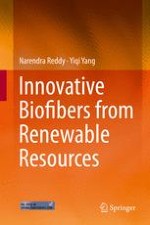2015 | OriginalPaper | Chapter
33. Microfluidic Spinning of Alginate Fibers
Chitin, Chitosan, and Alginate Fibers
Authors : Narendra Reddy, Yiqi Yang
Published in: Innovative Biofibers from Renewable Resources
Publisher: Springer Berlin Heidelberg
Activate our intelligent search to find suitable subject content or patents.
Select sections of text to find matching patents with Artificial Intelligence. powered by
Select sections of text to find additional relevant content using AI-assisted search. powered by
